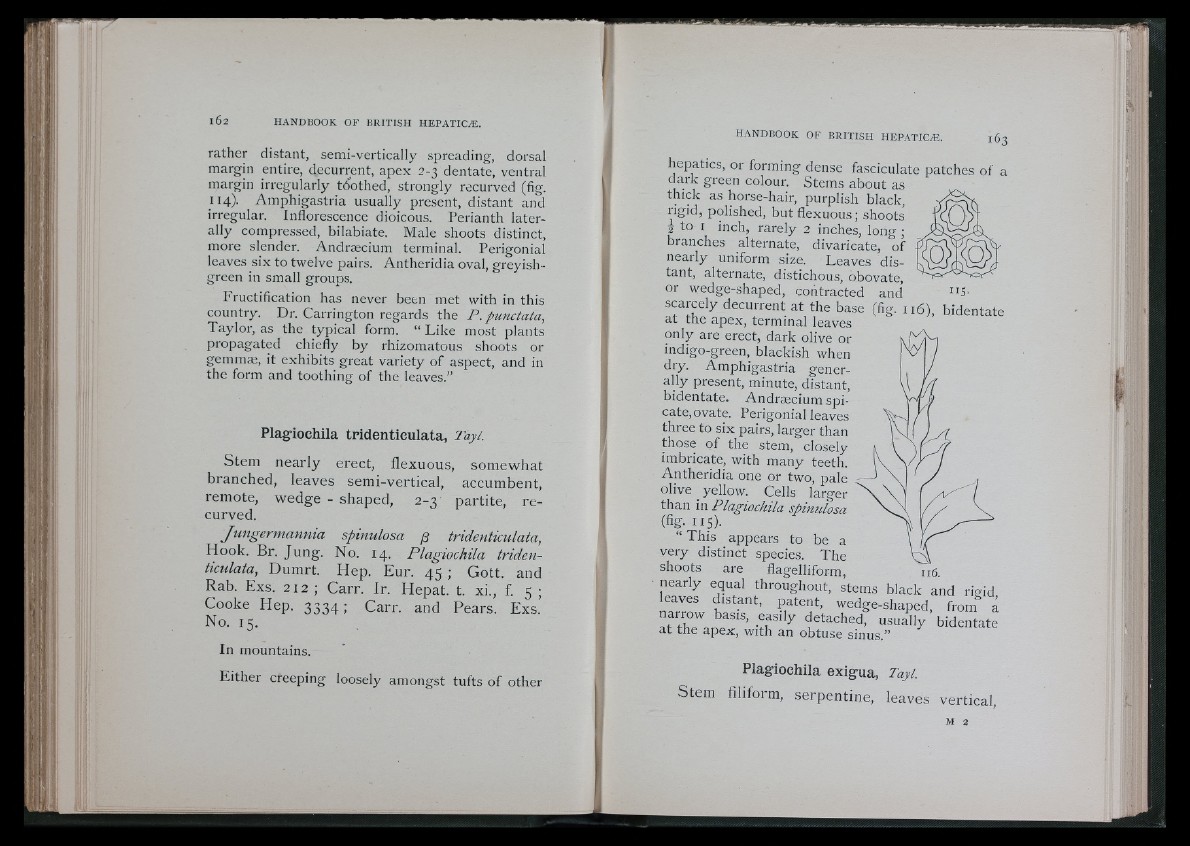
rather distant, semi-vertically spreading, dorsal
margin entire, decurrcnt, apex 2-3 dentate, ventral
margin irregularly t6othed, strongly recurved (fig.
114). Amphigastria usually present, distant and
irregular. Inflorescence dioicous. Perianth laterally
compressed, bilabiate. Male shoots distinct,
more slender. Andrrecium terminal. Perigonial
leaves six to twelve pairs. Antheridia oval, greyish-
green in small groups.
Fructification has never been met with in this
country. Dr. Carrington regards the P . punctata,
Taylor, as the typical form. “ Like most plants
propagated chiefly by rhizomatous shoots or
gemmre, it exhibits great variety of aspect, and in
the form and toothing of the leaves.”
Plagiochila tridentieulata, layi.
Stem near ly erect, flexuous, somewhat
branched, leaves semi-vertical, accumbent,
remote, wed g e - shaped, 2-3 partite, recurved.
Jimgermannia spinulosa p tridentieulata.
Hook. Br. Jung. No. 14. Plagiochila triden-
ticulata, Dumrt. Hep. Eur. 45 ; Gott. and
Rab. Exs. 212 ; Carr. Ir. Hepat. t. xi., f. 5 ;
Cooke Hep. 3 3 3 4 ; Carr, and Pears. Exs.
No. 15.
In mountains.
Either creeping loosely amongst tufts of other
hepatics, or forming dense fasciculate patches of a
dark green colour. Stems about as
thick as horse-hair, purplish black,
rigid, polished, but flexuous; shoots
i to I inch, rarely 2 inches, long ;
branches alternate, divaricate, of
nearly uniform size. Leaves distant,
alternate, distichous, obovate,
or wedge-shaped, contracted and “ 5-
scarcely decurrent at the base (fig. 116), bidentate
at the apex, terminal leaves
only are erect, dark olive or
indigo-green, blackish when
dry. Amphigastria generally
present, minute, distant,
bidentate. Andraecium spicate,
ovate. Perigonial leaves
three to six pairs, larger than
those of the stem, closely
imbricate, with many teeth.
Antheridia one or two, pale
olive _ yellow. Cells larger
than in Plagiochila spinulosa
(fig. IIS).
“ This appears to be a
very distinct species. The
shoots are flagelliform,
nearly equal throughout, stems black and rigid,
leaves distant, patent, wedge-shaped, from a
narrow basis, easily detached, usually bidentate
at the apex, with an obtuse sinus.”
Plagiochila exigua, Tayl.
116.
Stem filiform, serpentine, leaves vertical,